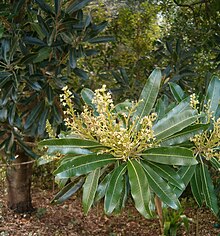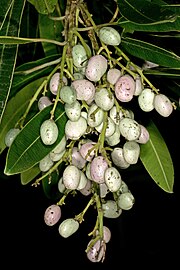Protorhus longifolia
| Red beech | |
|---|---|

| |

| |
| Scientific classification | |
| Kingdom: | Plantae |
| Clade: | Tracheophytes |
| Clade: | Angiosperms |
| Clade: | Eudicots |
| Clade: | Rosids |
| Order: | Sapindales |
| Family: | Anacardiaceae |
| Genus: | Protorhus |
| Species: | P. longifolia
|
| Binomial name | |
| Protorhus longifolia | |

| |
| Synonyms | |
| |
Protorhus longifolia, the red beech, is a medium to large, mostly dioecious species of tree in the family Anacardiaceae. It is native to South Africa and Eswatini, where it occurs in well-watered situations from coastal elevations to 1,250 m.[2] The leafy, evergreen trees have rounded crowns and usually grow between 6 and 10 m tall, but regularly taller in forest.[2]
Range[edit]
In South Africa they occur from the Eastern Cape to Limpopo.[3] In Eswatini it is present in the western uplands, and in the Lebombo regions.[4] They occur in coastal, scarp and mistbelt forests, rock outcrops, escarpments, riparian fringes, or in woodland.[5]
Bole and branches[edit]
The bole is up to 1 m in diameter in forest. The bark of a young tree is smooth and brown, but becomes darker and rough with age.[5] The branches have a rough texture and retain leaf scars.[2] They exude a sticky milky sap when broken.[5]
Foliage[edit]
The trees often carry some strikingly yellow or red leaves, especially in winter[2] or on new growth. The simple leaves resemble Mango leaves, and have a scattered, alternate or subopposite arrangement.[5] They measure up to 15 by 3 cm,[2] and are paler below than above. They are glabrous and leathery in texture, and linear-oblong to narrowly elliptic in shape.[6] The leaf margins may be frilled or wavy and are tightly rolled under.[5][7]
The primary, lateral veins have a straight and parallel arrangement. They terminate on, and often fork near the leaf margin. There are up to 40 veins a side,[2] which are prominently raised below.[6] They are light in colour, contrasting with the dark, glossy upper surfaces.[8]
Flowers[edit]
The flowers are small (±4 mm in diameter) and are carried in axillary[2] or terminal panicles.[3] They are greenish-white (male)[4] or pink to red, and appear in early spring (August to October).[7] The ovary is ovoid and the calyx is saucer-shaped. The floral parts are in fives,[7] but female flowers have three styles.[4]
Fruit[edit]

The indehiscent fruit which appear from October to December, are smooth, fleshy drupes[6] that mature to a pale mauve colour[8] in autumn.[2] Each contains a single seed.[6] (cf. Ozoroa)
Species interactions and uses[edit]
Various forest mammals and birds feed on the fruit while on the tree, or after they are dropped, while the bark and foliage are browsed by Black rhino.[3]
The fine-grained wood has been used for furniture, planks[3][5] and fence posts,[9] but is not considered very durable.[7] The ground up bark, though somewhat poisonous, is used as "red" muti (Zulu: uMuthi-embomvu).[5] The sticky milky sap has been used a glue, for instance to fix assegai blades to their handles, or as a depilatory.[7]
The species can be cultivated from fresh seed and does well in gardens. They are useful as specimen trees or screening plants,[8] and grow relatively fast, up to 80 cm a year.[3] Though it thrives in warm, moist regions, it is also tolerant of drought and slight frost.[8]
Gallery[edit]
-
Old bark texture
-
Young foliage
-
Habit in forest
References[edit]
- ^ Botanic Gardens Conservation International (BGCI).; IUCN SSC Global Tree Specialist Group. (2019). "Protorhus longifolia". IUCN Red List of Threatened Species. 2019: e.T149511484A149511486. doi:10.2305/IUCN.UK.2019-2.RLTS.T149511484A149511486.en. Retrieved 2 April 2024.
- ^ a b c d e f g h Palmer, Eve (1977). A Field Guide to the Trees of Southern Africa. London, Johannesburg: Collins. pp. 282–284. ISBN 0-620-05468-9.
- ^ a b c d e Pooley, Elsa (2006). Forest plants in the forest and in the garden. Pinetown: The flora publications trust. p. 47. ISBN 0-620-37012-2.
- ^ a b c "Protorhus longifolia (Bernh.) Engl". Swaziland's Flora Database. SNTC. Retrieved 18 April 2014.
- ^ a b c d e f g Pooley, Elsa (1997). Trees of Natal, Zululand and Transkei. Durban: Natal Flora Publications Trust. p. 244. ISBN 0-620-17697-0.
- ^ a b c d Van Wyk, Braam; et al. (1997). Field Guide to Trees of Southern Africa. Cape Town: Struik. p. 87. ISBN 1-86825-922-6.
- ^ a b c d e Palgrave, Keith Coates (1984). Trees of Southern Africa. Cape Town: Struik. p. 463. ISBN 0-86977-081-0.
- ^ a b c d "Protorhus longifolia". Trees. Witbos indigenous nursery. Retrieved 17 April 2014.
- ^ Immelman, W. F. E.; et al. (1973). Ons Groen Erfenis/Our Green Heritage. Cape Town, Johannesburg: Tafelberg. p. 51. ISBN 00-624-00371.




